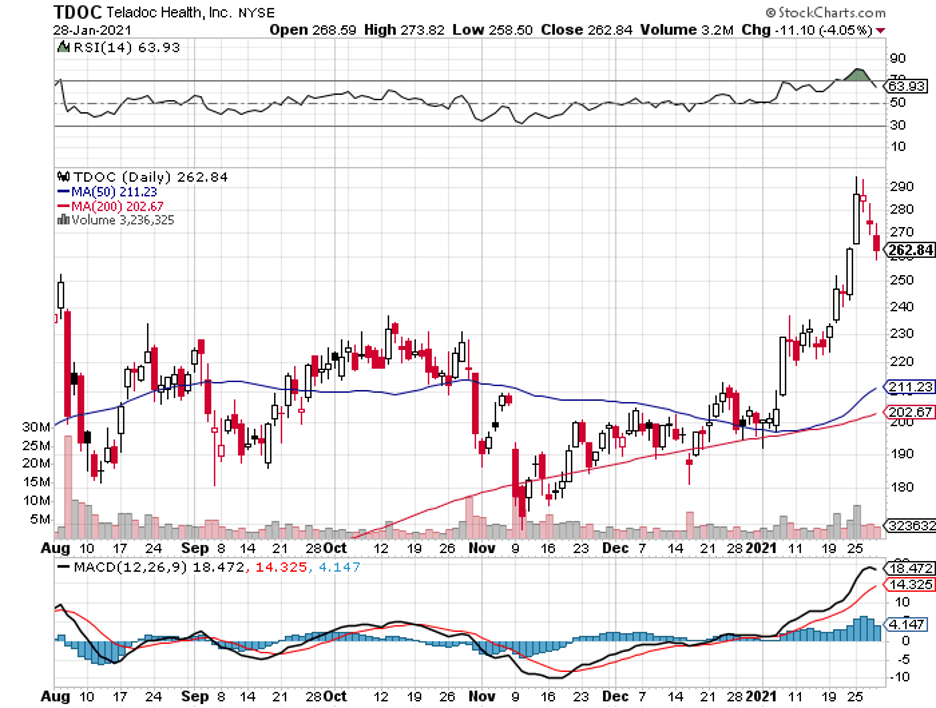The decision to invest in FAANG stocks—Facebook (FB), Apple (AAPL), Amazon (AMZN), Netflix (NFLX), and Google (GOOGL)—is basically a no-brainer.
These are some of the most highly rated stocks to date, and these companies continue to grow in value.
In fact, they managed to soundly outperform the 16% returns of the S&P 500 in 2020, with the weakest stock in the list, Google’s Alphabet, climbing 31% while Apple rose by an impressive 81%.
Outside of FAANG, those who read my Mad Hedge Technology Letter know of the advantages of Software-as-as-a-Service (SaaS) and the growth of the companies behind it.
I’ve always been a fan of emerging innovations, and this is one of the reasons why I’m excited about the collaboration between technologies like SaaS to bolster age-old industries like the healthcare field.
It’s dubbed healthcare-as-a-service (HaaS).
So far, one promising stock comes to mind when it comes to HaaS: Teladoc Health (TDOC).
Teladoc is one of the companies that benefited massively from the COVID-19 lockdowns.
So far, this healthcare stock is up by over 40% year to date after skyrocketing 139% in 2020.
During the first nine months of 2020, it recorded a whopping 163% rise on virtual visits compared to the same period in 2019. Meanwhile, its revenue rose by 79%.
The convenient technology it offers, which allows patients to connect with physicians without physically visiting the doctors’ offices, allowed Teladoc to enjoy strong growth amid the pandemic.
However, Teladoc isn’t merely a reasonable investment during the COVID-19 pandemic.
The company has been quietly gaining traction in the past years.
In its 2015 to 2019 reports, Teladoc reported an impressive growth in its revenues at 78%, 59%, 89%, 79%, and 32%, respectively.
The telehealth market is projected to grow to nearly $560 billion by 2027—an estimate that’s over 9 times the $61.4 billion the industry was worth in 2019.
Needless to say, the growth in the telehealth industry is just beginning, and Teladoc is well-positioned to take advantage of the momentum.
In 2020, it has strengthened its position with its massive $18.5 billion merger with Livongo Health.
Given Livongo’s more specialized portfolio, which puts a premium on chronic care and diabetes, the newly combined companies can offer a more extensive scope of telehealth services.
By 2023, the combined Teladoc and Livongo is estimated to generate more than $3 billion in sales alone.
As for its 2021 plans, Teladoc welcomed the new year with a partnership with continuous glucose monitoring (CGM) systems manufacturer DexCom.
With this collaboration, the company would be able to offer its users “CGM-powered insights.”
In other words, patients would be able to conveniently see and monitor their own glucose levels.
While Teladoc clearly benefited from its partnerships with Livongo and DexCom, its core business continues to show strong growth.
In its third quarter earnings report, which was released days before its Livongo merger, it more than doubled its $138 million sales in 2019 to $288.8 million in 2020.
Meanwhile, the total number of its telehealth visits increased by a staggering 206% to reach 2.8 million.
With the addition of new services in its roster, Teladoc is presented with a considerable growth opportunity just by simply boosting the usage of its current clients.
To give you a better picture of how big this could get, the company recorded a total of 73 million members by the end of the third quarter last year.
Following the mergers and the new deal last January 2021, Teladoc is anticipating an additional 65 million clients.
Teladoc is one of the most exciting healthcare stocks out there today. Its move to combine technology and doctor’s visits make it a uniquely innovative and stand-out business in an age-old industry.
More importantly, it has shown that its growth is not solely reliant on the demands brought about by the COVID-19 pandemic. Instead, it has made key moves to fortify its market share.


